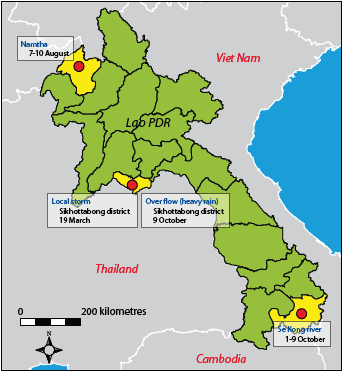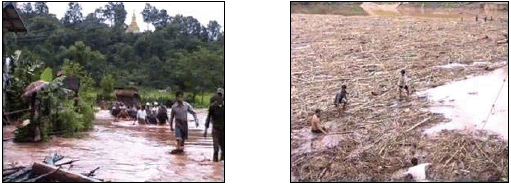5. Lao PDR 2006 Country Report
5.1 General situation
During 2006 localised flash flooding in Luang Namtha and Attapeu provinces were the only noteworthy flood incidents that occurred in Lao PDR (Figure 27). Events in Luang Namtha during the second week of August were in response to orographically induced monsoonal storms which produced 230 mm to 270 mm of rainfall over the first 10 days of the month. The flooding in Attapeu province during the first week of October was attributable to the incursion of Severe Tropical Storm Xangsane. Elsewhere the only meteorological episodes of any significance were local storms over Vientiane which caused brief urban flooding in March, May and October and a highly localised ‘whirlwind’ which moved at high speed through the Chanthabouly district of the capital at 7:25 pm on the 5th May, with wind speeds of over 100 kph (30 m/sec) causing severe structural damage to numerous buildings.

Figure 27. Lao PDR—provinces affected
by flash floods and local storms during 2006.
5.2 Flash flooding in Luang Namtha province
The rainfall from the local monsoonal storms during early August reached maximum intensities on the 6th and 7th of the month, with totals in excess of 100 mm widely observed for the two days. In response the Luang Namtha River rose over 5 metres in 12 hours and inundated its natural floodplain to a depth of 1.2 metres and more. At Hongleuai hydrometric station the maximum water level of 13.25 m was more than 3 metres higher than the danger level. The resulting flash flood inundated 132 villages, and affected 1,916 households in the NamTha, Long, Sing, Viengphoukha and Nale districts. (Plates 1 and 2)

Plates 1 and 2. Army and police
supervise the evacuation of residents of Dounamphanh village
and locals begin to clear rubbish trapped in the Luang Namtha
weir (August 2006).
5.3 Flash flooding in Attapeu province
Rainfall intensities in the upper Nam Xekong and Xekhaman catchments associated with incursion of Severe Tropical Storm Xansane during the first week of October over the south of Lao PDR are estimated from satellite imagery to have exceeded 100 mm in 12 hours. Water levels in the Xekong River at the Ban Veunkhen hydrometric gauge rose 9 metres in 48 hours and as a consequence inundation of the natural floodplain was rapid. The five provincial districts of Samakkhixay, Sanamxai, Phouvong, Xaisetha and Sanxai were affected by the flash flooding, with river water levels almost 1.5 metres above their critical levels. In all over 270 villages in Attapeu, Champassak and Saravan provinces were inundated to a greater or lesser degree (Plates 3 and 4).

Plates 3 and 4. Samakkhixai district,
Attapeu province—flash flooding during the first week of October
associated with Severe Tropical Storm Xangsane.
5.4 Damage and impacts
This local flash flooding in the far north and far south of Lao PDR during May and October affected over 400 villages and 13,500 households, according to Ministry of Agriculture and Forestry and National Disaster and Management Organisation figures. Five people were killed and almost seven million hectares of rice and other crops were damaged (Appendix 6). There were some livestock losses and some damage to national infrastructure was recorded. Direct economic losses are estimated to have been US$3 million, which is a comparatively small figure and less than 20% of the economic losses incurred in 2005, which was not in itself a year of particularly severe or extensive flooding.
5.5 Lessons learnt
- The Department of Meteorology and Hydrology operational staff concerned with extreme weather events, typhoons, floods, flood monitoring and forecasting successfully consolidated their experience and expertise during the events of 2006.
- A meeting one month before the start of the monsoon season of the National Disaster Management Committee, with representatives drawn from 13 ministries, and with the aim of clarifying responsibilities and coordination was found to be most useful. A second annual post flood season meeting to assess the performance of the relevant agencies and ministries would have significant additional benefit.
- Effective medium and long-term flood forecasts are required to prepare the agricultural sector, the national flood management programme and the relevant national agencies for the management and mitigation of flood impacts.
- The weather, typhoon and flood forecasting skills as well as the procedures for issuing and disseminating flood warnings from the Department of Meteorology and Hydrology must continue to be improved from year to year. Official procedures to ensure even closer coordination between the Department, the mass media, relevant ministries and line agencies should be prepared.
- Knowledge and experience of flash floods and the ability to forecast them needs to be improved and the facility to communicate and disseminate warnings to high risk areas requires more consideration. A start lies in identifying, zoning and mapping these high risk areas.
- Close coordination with the Regional Flood Management and Mitigation Centre in Phnom Penh is essential and should be further reinforced.
Choose a newsletter: